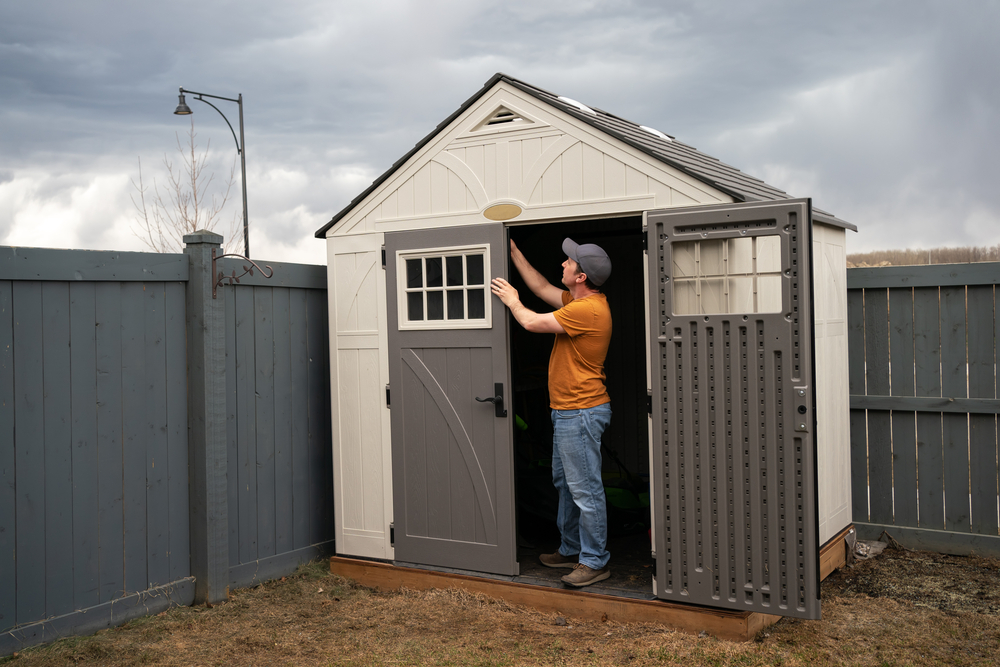Ahhh … the shed. A quintessential outdoor Aussie construction where we store all manner of stuff that doesn’t belong (or won’t fit) anywhere else! In many households, it’s also a dwelling where the man and/or woman of the house (in their “man cave” or “she shed”, respectively) can retire to soak up some much-needed peace and quiet.
But if you don’t have a shed (or would like a “his and hers” equivalent), it’s not as simple as just plonking one down in the backyard. Rules and regulations need to be followed, and, just like fencing laws, these can differ between states and local councils. In some instances, the penalties for not conforming to these regulations can also be costly. However, it’s not all doom and gloom. A quick phone call to your local council is often all it takes!
So if you’re asking yourself questions like how close can a shed be to a fence or what’s involved with building a shed on a fence line, here are some general guidelines.
Queensland
Shed placement in Queensland requires compliance with the Queensland Development Code and the applicable Planning Scheme provisions. Generally, the Code requires that all buildings and structures be:
- Sited a minimum of six metres from all road property boundaries (fence lines);
- No more than 10 square metres in the area after building work is completed;
- No more than 2.4 metres high; and
- No longer than five metres along any side.
New South Wales
In New South Wales, many minor projects aren’t likely to require Council approval as they fall under the “exempt developments” section in the law. However, your fence will need to meet some specific requirements, including:
- It should be set back a minimum of 900mm from each boundary.
- It should be no higher than three metres above ground level.
- In residential zones, it should be no larger than 20m2.
- There are no more than two structures per property.
- It cannot interfere with the entry to, the exit from, or the fire safety measures within another building.
- If your property is on bushfire-prone land, it must be constructed of non-combustible materials.
Victoria
In Victoria, a building permit is generally required for sheds greater than 10m² in floor area. For sheds not more than 10m² in floor area, a building permit is not required providing the shed is:
- No more than three metres in height or if within one metre of a boundary, not more than 2.4 metres in height;
- Associated with a building of a different class on the same allotment, i.e. a dwelling, office building, etc.;
- Located no further forward on the allotment than the front wall of the associated building; and
- Not constructed of masonry.
South Australia
In South Australia, approval from your local council may be required if the garden shed being added to your home or a domestic residence is:
- Higher than 2.5 metres above natural ground level;
- Larger than 15m2 in area;
- Spans greater than three metres; and
- The subject of any obstructions.
However, even though your development may comply with the above, you may still be required to obtain planning approval if the structure is located between an existing building and the road frontage, or if it’s closer than 900 metres to the secondary street boundary for corner blocks.
Western Australia
In Western Australia, generally, any shed less than 10m2 doesn’t need building licence approval. However, your shed should be:
- Installed behind the prescribed front setback line (the minimum distance between the edge of your property and where the structure will be built);
- Located to the side of the rear area to comply with the Fire Safety Code of Australia (i.e. 900m away from other structures);
- Up to code safety standards and built with quality materials that can withstand adverse weather; and
- Have a maximum height of 2.4 metres and a floor/deck no more than 500mm above natural ground.
Tasmania
In Tasmania, general approval for a shed construction (a small shed up to 18m2 or a prefabricated steel shed up to 36m2) is determined on a low-risk assessment. This allows the owner to carry out the project without a permit. However, you may need to submit a form for your Council’s approval. Once construction is completed, you will need to notify your Council using a ‘Notification of Low Risk Work’ form confirming that your shed:
- Is set back one metre from the boundary;
- Is not constructed of masonry;
- Is added to a building of another Class on the same allocation;
- Is not built further forward on the location than the front wall of the property; and
- The floor area is not more than 10m².
References
- 2022, Queensland Shed Council Approval Information, Cheap Sheds
- 2022, New South Wales Shed Council Approval Information, Cheap Sheds
- 2022, Victoria Shed Council Approval Information, Cheap Sheds
- 2022, South Australia Shed Council Approval Information, Cheap Sheds
- 2020, Do You Need a Permit to Build a Shed in Perth? The Shed Man
- 2022, Tasmania Shed Council Approval Information, Cheap Sheds

